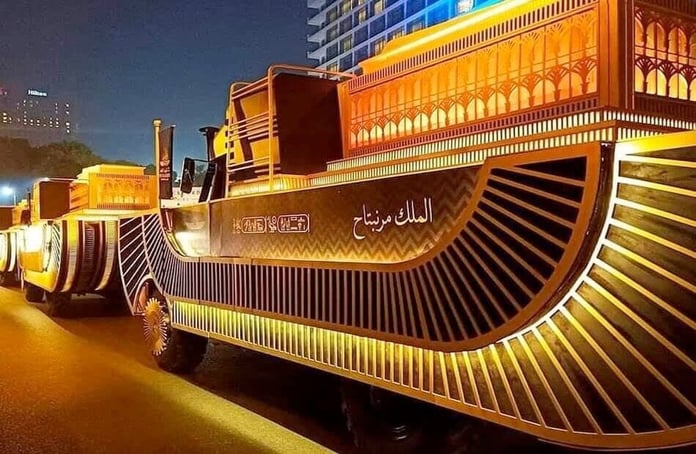
The mummies of 22 kings and queens from the time of the Pharaohs, including Ramses II and Hatshepsut, travelled on Saturday in a “procession” that the streets of Cairo had never seen before on their way to settle in their new location in the National Museum of Egyptian Civilization in the south of the capital, reports the BBC .
The mummies of 18 kings and four queens from the ages of the seventeenth to twentieth pharaonic families will be transported on carriages decorated in the Pharaonic style bearing their names, respectively, according to the chronological order of their rule, starting from 6 pm Cairo time (16:00 GMT).
The motorcade will travel seven kilometres to the National Museum of Egyptian Civilization, on a 40-minute journey, amid tight security measures.
– Close the field –
In Tahrir Square, which is adorned with an obelisk and four Pharaonic rams, the authorities officially announced the closure of the metro station on Saturday, from twelve in the afternoon until nine in the evening. The field will also be closed to cars and pedestrians.
The Ministry of Interior also published a list of roads and streets that will also be closed for the occasion in the vicinity of the procession route.
Egyptian archaeologist Zahi Hawass, who will comment on the procession during the live broadcast on television channels, said, “The whole world will watch this royal procession … It will be an important forty minutes in the life of Cairo.”
The National Museum of Egyptian Civilization, a modern building in the historic city of Fustat in the Old Cairo region, south of Cairo, will open its doors on Sunday after part of it was opened in 2017.
But the public will not be able to see the royal mummies until the 18th of this month.
The procession is led by King Seknen Ra of the seventeenth Pharaonic dynasty (sixteenth century BC) and concludes by King Ramses the ninth of the twentieth pharaonic family (twelfth century BC).
The “Golden Pharaohs” procession will include King Ramses II and Queen Hatshepsut, who are widely known among the public and will be accompanied by music by Egyptian artists.
– The Curse of the Pharaohs –
Egypt will also open, within months, another museum, the Grand Egyptian Museum near the pyramids of Giza, which will also contain Pharaonic antiquities, most notably the mummy of Tutankhamun (the fourteenth century BC) and his entire group that was discovered in 1922.
Walid Al-Batouti, an advisor to the Minister of Tourism and Antiquities, said that the presentation “shows that after thousands of years, Egypt still has a great appreciation for its leaders.”
The “royal motorcade” sparked many comments on social media, and Egyptians did not spare the sense of humour and triviality, who considered that the delinquency of the ship in the Suez Canal and the Upper Egypt train accident, which killed 18 people in recent days, was the product of the “Curse of the Pharaohs ” who express their dissatisfaction with their transportation. From their current shrine.
Egyptians used to describe any sad or tragic event as a product of the “curse of the pharaohs”, as a matter of tundra.
The “curse of the pharaoh” was mentioned in the 1920s after the tomb of Tutankhamun was discovered, and the deaths that followed were considered mysterious among the members of the team of archaeologists who discovered it.











